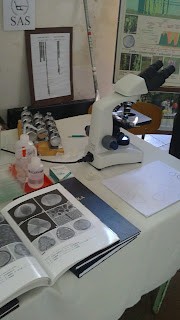Last weekend there was a medieval festival in Lad village (30 kilometers to the west of Konin). The name of the event was The 9th Festival of Slavic and Cistercian Culture in Lad (in Polish: IX Festiwal Kultury Słowiańskiej i Cysterskiej w Lądzie nad Wartą). It is organized every year and every time it has different subject. 9th edition was about "Medieval villages and parishes".
 |
| Cistercian monastery in Lad. View from the south, from monastery's gardens. |
The history of these interesting events starts in 2005 when the first festival had its place. It was organized under the name "The 1st Festival of Slavic and Cistercian Culture in Lad" with the unique subject: "We are building gord and monastery in Lad". The event was connected with a fact of reconstructing of medieval Slavic wooden fortress. Next year in 2006 the recontruction was completed and reenactment groups could live in buildings of the gord like in medieval times. It was also possible to stage the siege. The festival in 2006 dealed with subject: "Monks, warriors and peasants". Next festivals treated with such subjects like:
2007 - Pilgrimages and journeys,
2008 - People, forest and wolves,
2009 - Love, ladies and knights,
2010 - Missions, churches and monasteries,
2011 - Land, home and guests,
2012 - Kings and bishops.
Nowadays, Lad (Ląd) is a small village situated on the north bank of the Warta River. In middle ages it was important wooden fortress which guarded ford on the river. The gord was built in 9th/10th century. In half of 10th century probably it was incorporated to country ruled by Piast dynasty. Later it became a capital of castellany. Archeologists during excavations found remains of two temples in the gord. There were Saint Andrew Church and Saint Peter Church. The fortress was destroyed in 13th century during wars in time of feudal division of Poland. The remains of medieval Lad are situated to the south of the modern village. People call them Rydel's Mountain (in Polish: Rydlowa Góra). Sometimes during festivals there are organized trips to the mountain.
It is not only one historical monument in Lad. There is also Cistercian monastery which was built in 1145. It is a huge medieval building complex. During festivals monastery opens almost all rooms to the visitors. Presently it is inhabited by Salesians of Don Bosco. Last Cistercian monk left the monastery in 1848. The history of the Lad monastery is really interesting and I will write separate post about it soon.
 |
| Eastern part of monastery. |
The festival lasts two days but in fact it starts one day before in the evening when there are coming first reenactement groups. It is always organized in weekend. Whad does the event offer to the visitor? The answer is complex because there is always happening many things. Visitor can see reenactement of medieval life. There is possibility to: watch medieval battles, to talk with scholars (historians, archeologists, medievists and other scientists) who gives lectures on chosen medieval subjects, acquiant with medieval craftsmenship, listen medieval music, watch medieval theater, speak with reenactors, eat old-time dishes. There are also activities for children. For example this year my daughter made a pendant in shape of medieval ones.
 |
| Medieval ironmaster and his bloomery. |
I must admit that I participated six times in the festival. Four times as a visitor and two times as a reenactor. It was in time when me and my wife took a part in early medieval life reenactement movement. This year we were present as a visitors.
 |
| The stall of the medieval beekeeper. |
The festival has its own web-site and a Facebook profile. If you want to know more about them and to track news you can easly find them typing words: "festiwal lad" in Google and you will get it.
 |
| Camp of early medieval reenactment groups (placed near of the reconstructed gord). |
 |
| Camp of late medieval reenactment groups (placed near of the monastery). |
 |
| Late medieval duel between two knights. |
 |
| Press in woodcutter's booth. |
 |
| Coat of arms - effect of woodcutter's work ready to be used in the press. |
 |
| Reconstruction of the medieval seals. |
 |
| Some real medieval artifacts (in the booth of the archeologist). |
 |
| The stall of the palynologist whose works help archeologists to assess what kind of plants were present in medieval Poland. |
 |
| Inside the monastery. |
 |
| The author of this blog and his wife and daughter during the 7th festival in Lad. Photo taken in 2011. |
Key words: festival, Фестываль, Фэстываль, Фестивал, festivalo,
jaialdi, festivaali, fesztivál, hátíð, festivāls, фестиваль, фестівал, lễ hội, gouel-meur,
festiwal, مهرجان, ܥܕܥܐܕܐ, উৎসব, དུས་ཆེན།, جشنواره,
ઉત્સવ, פסטיבל, उत्सव, 祭, ಹಬ್ಬ, 축제, ഉത്സവം, उत्सव, उत्सव,
नखः, ପର୍ବ, भारतीयपर्वाणि, திருவிழா, పండుగ, เทศกาล, 節, 节日














Brak komentarzy:
Prześlij komentarz